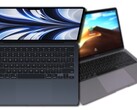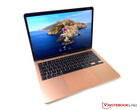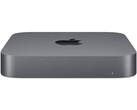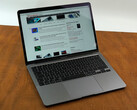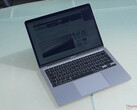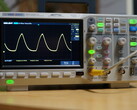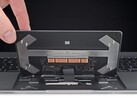The MacBook Air is "the" subnotebook and mobile companion for many users. Apple did not really update the the model for a couple of years, but it still sold well thanks to the lower prices. The first major update was back in 2018 including a much better display. Two more big issues, the Butterfly keyboard (or more precisely the reliability issues) as well as the performance of the efficient dual-core processor are being addressed in the 2020 update. We now had the new model with the faster quad-core processor in review and Apple definitely missed an opportunity here, and maybe they did it on purpose.
But we want to start with the good things. The display is still unchanged and still very good, even though the Windows competition has closed the gap by now and is even ahead in some aspects (e.g. brightness). The great aluminum chassis is slightly thicker this year to make room for the new keyboard. We like the new typing experience and it is very similar to older MacBooks before the Butterfly era. The battery runtimes are still on a high level and Apple even managed to improve the speaker system a bit.
However, there are also some negative things, and to be honest, we cannot really understand why these decisions were made. Apple uses custom Intel processors, which are based on the current Ice Lake generation and it is the first time you can get quad-core chips in the MacBook Air. The chips still belong to the ultra-low voltage Y-series, which is usually pretty easy to cool considering the low TDP. Apple keeps the curious cooling system with an additional fan inside the chassis, which can get very loud at 45 dB(A) under load. Too loud for the performance, and the performance is still reduced after a couple of seconds. The other thing we don't understand is why Apple still waives Wi-Fi 6, even though it is already partly integrated into the new Ice Lake chips.
The performance itself is not even the big problem, because the new MacBook Air is sufficient for common tasks, and casual users are definitely the main target group for the Air. Apple also wants to keep the distance to the MacBook Pro models. But why does Apple not cool the SoC completely passively and remove the fan. The best example for this approach is the Microsoft Surface Pro 7, where both the Core i3 and Core i5 SKUs (by the way 15W chips) are passively cooled. The result is a much higher short-term performance and although the sustained performance obviously drops, the result is still better compared to the MacBook Air.
Maybe Apple did not want to put too much engineering effort into this update, because this model will probably once again sell very well. We also suspect that it won't be long before Apple will launch the MacBook Air with ARM processors (which have been rumored for years). The iPad Pro 11 already offers more CPU performance. this would be a good chance for Apple's marketing department and promote its own SoCs (faster than previous Intel chips, more efficient, no active cooling, etc.). However, we will have to wait a bit longer for this device.
Until then, the current MacBook Air is still a good choice fir many users who just want a great laptop for basic stuff. Still, the MacBook Air could already be much better.





